1942: Tweety and... Conrad?
Despite some very bleak times in the world (which will also be reflected in the contents of many of the cartoons – some of them obviously wouldn't show up much in the later TV airings), the WB cartoons are doing extremely well.
Hop Skip and a Chump
Directed by I. Freleng
The fast and cunning grasshopper Hopalong Casserole outwits two dumb crows who try to catch him. This is a fun one-shot with charismatic characters — could there have been potential for more? Hopalong is a trickster slightly similar to Bugs, while the crows (based on Laurel and Hardy) have entertaining chemistry. There's another well-timed musical gag, and the ending has one of the best fourth wall breaks in the series (surprising from Freleng who hasn't used them as much as some of the other directors).
9.5
Porky's Pastry Pirates
Directed by I. Freleng
Porky owns a sanitary bakery where bugs are absolutely not welcome! A bee manages to get there and eat many of the delicious pastries by threatening him with his stinger, and the pig's attempts to get rid of the pest aren't successful. A fly then tries to do the same by pretending to be a bee. Another amusing entry, I especially like the tough guy bee. The ending is my favorite part, though!
8.5
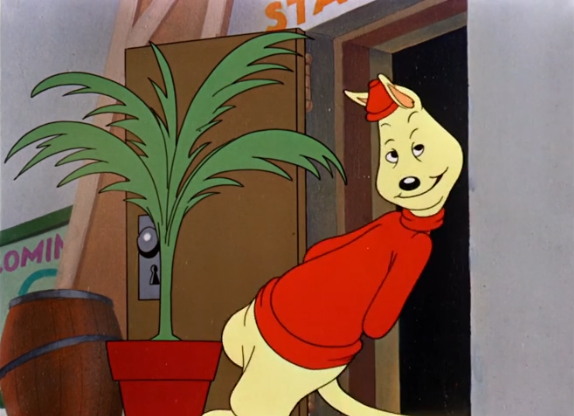
The Bird Came C.O.D.
Directed by Charles M. Jones
Conrad the Cat is a delivery driver, bringing a palm tree to a theater. After difficulties fitting the tree through the door, the hapless cat spots a top hat and pretends to be a stage magician. But this angers the pigeon (the one from "Stage Fright") living inside the hat. A strange cartoon. Again, there's no dialogue, just sound effects. Conrad's repeated chuckle treads the line between sympathetic and annoying, since it's heard over and over especially in the first minutes of the short. The rest of the cartoon, while beautifully animated, mostly feels like random stuff put together – though I quite like the pigeon, the tree sequence was more to my liking. Some sources claim this short almost got Jones fired from the studio – it's not that bad, but not his finest seven minutes either. But introducing new characters to the series was where he really led the way at this point. Many of them never really took off, but Conrad was yet another attempt, appearing in three cartoons in very close succession.
7
Aloha Hooey
Directed by Fred Avery & Robert Clampett (both uncredited)
Stowaways on the S.S. Sabotage, Cecil Crow and Sammy Seagull have sailed to Hawaii. They set their sights on beautiful Laylani, both trying their best to impress her, with Sammy having more success. But there's a mandatory villain in the short, of course... I found this a cute and funny short, despite not being either director's absolute best (but you can expect Avery and Clampett to deliver most of the time anyway). Mel Blanc and Pinto Colvig give the main characters a lot of personality with their charming voice acting. I also like how the two birds are genuine friends – while they compete to impress the same girl, they never resort to fighting, remaining respectful and helpful to each other, even after Laylani makes her decision. Who knew the two wackiest directors would be responsible for what might be the best friendship in the entire series?
9
Who's Who in the Zoo
Directed by Norman McCabe
Porky is the keeper of the Azusa Zoo, and we see him at work. But most of the focus is on visual puns and funny antics involving the various animals of the zoo. The lion seems to be looking for something... While McCabe took over Clampett's old unit (and seems to be equally disinterested in giving Porky much of the spotlight), this generally has the feel of an Avery spot gag cartoon – the most obvious similarity being to "A Day at the Zoo", obviously. The gags are different this time, including a couple of topical ones related to the war effort.
8.5
Porky's Cafe
Directed by Charles M. Jones
In his café, Porky manages to serve a customer who makes strange requests with no trouble (on Porky's side, not so much the customer's). However, his employee Conrad the Cat is having more difficulties baking pancakes, especially when an ant ends up in the pancake batter, eventually leading to a wild chase. Conrad becomes the fastest character to appear in both a Merrie Melody and Looney Tune, just two other shorts having been released between those. Despite being an improvement over his first appearance, his ant-ics (sorry!) are probably the weakest part of the short – there are more imaginative gags in the Porky scenes, like the letters in an alphabet soup being produced with a typewriter. There's also an early appearance of the Rube Goldberg machines Jones loved to use, as a very complex machine is used to make a simple egg toast. The ending is also a fun one!
8
Conrad the Sailor
Directed by Charles M. Jones
Conrad is swabbing the deck of a ship he and his fellow sailors sail on. But Daffy has walked on the deck, leaving his footprints all over, and keeps annoying the cat who desperately tries to get rid of him. Out of the three shorts featuring Conrad, this is by far the best for several reasons, not least his new voice, which gives him some much needed personality. Daffy is a great foil for him, just like for many other characters. "The Song of the Marines", often used in navy-themed shorts (like the earlier "Porky the Gob"), is an absolute earworm, and here we hear a humorous rendition by Conrad, with Daffy making fun of his singing. There's a funny running gag with Conrad and Daffy stopping whatever they were doing to salute the captain. All in all, it's one of Jones' best so far, with some of his most entertaining gags and best pacing. This was Conrad's last appearance – his short but eventful career makes him one of the fastest recurring characters to be retired!
9.5
Crazy Cruise
Directed by Fred Avery & Robert Clampett (both uncredited)
A travelogue cartoon, showing us wildlife and attractions around the world. Naturally, there are some cultural references from the time, as well as war-themed gags. The ending gag is my favorite, featuring a surprise cameo! The very last WB short to feature any work by Tex Avery isn't his best spot gag cartoon but definitely an enjoyable one.
8.5
The Wabbit Who Came to Supper
Directed by I. Freleng
Elmer is hunting rabbits again and has Bugs trapped. But then he gets a telegram and finds out his uncle Louie is leaving him three million dollars. The only condition: he doesn't harm any animals, especially rabbits! Bugs obviously takes advantage of this, staying in Elmer's house and repeatedly annoying him. The basic idea of Bugs staying with Elmer and being a nuisance was already used in "Elmer's Pet Rabbit", but this short is clearly the superior one. In light of the early conflict, there's more of a reason for Bugs' treatment of Elmer here, and with the development in the previous shorts, the rabbit's personality is much more likable than in that one. Elmer also has a clear motive to at least to try to tolerate his behavior. We see some great character acting (including fourth wall breaking) from Bugs, and many great gags made even better by the vocal performances. Another early Bugs masterpiece – with such a strong run, it's no wonder he immediately became such a popular character!
10
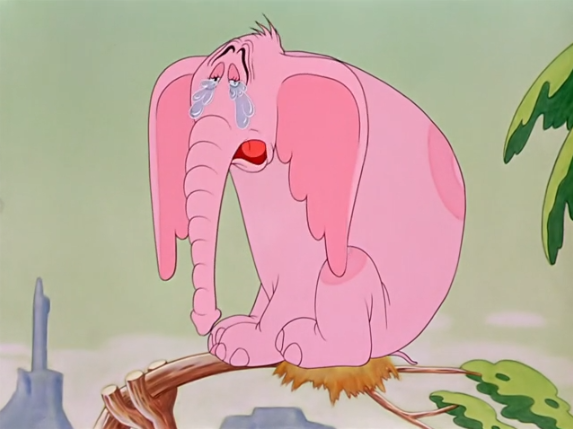
Horton Hatches the Egg
Directed by Robert Clampett
Despite the apparent failure of "Mighty Hunters" in 1940, another Merrie Melodies cartoon was made that was based on an outside property, this time the popular children's book by Dr. Seuss (whose name pops up in WB cartoon history a few times, the first one having been the two lost Flit ad cartoons from 1931). Lazy bird Mayzie is tired of sitting on her egg, instead wanting to go on vacation. She manages to convince Horton the elephant to hatch the egg for her. But as Mayzie doesn't return, the elephant faces everything from stormy weather to hunters – but "an elephant's faithful one hundred percent"! The animation in this short is amazing, especially Horton's funny way of walking. Clampett adds his own touches to the story, with the addition of gags like Mayzie's Katharine Hepburn impersonation (the WB crew seemed to like her – really they did!) and Horton repeatedly trying to sing the then-popular "Hut-Sut Song" but not remembering the words. But at the same time, I was positively surprised how faithful (if not quite one hundred percent) this is to the original story at its core – Seuss' great rhyming writing was preserved, and the designs combine his original illustrations with Clampett's style. With plenty of comedy and even some emotional moments, I'd go as far as to say it's one of the best Clampett and the Schlesinger crew ever made.
10
Saps in Chaps
Directed by I. Freleng
The Looney Tunes really start moving away from the Porky focus now, with the third one-shot in the series (which will be so common from now on that it's not really worth mentioning anymore) – in fact, he won't appear again until the second last cartoon of the year. We look back at the American settlers heading westward in this spot gag cartoon. We see a thirsty man in the desert and a hero in a saloon who literally laughs at danger among others, with the highlight being a visit to the rodeo. Apart from some amusing jokes (the anthropomorphic horses being the most entertaining), I found this a fairly weak one compared to many others from the time. Even with the overall theme, I feel there was less of a connection between some of the gags than usually in these cartoons, and many of them weren't particularly memorable.
7
Dog Tired
Directed by Charles M. Jones
The Curious Puppies end up in a zoo where they have run-ins with various animals. The big dog ends up in a kangaroo's pouch, while the small one keeps losing its bone. A laughing hyena finds their antics hilarious. While all the cartoons with these dogs are very similar, this one might be the best, even if the other characters tend to steal the show, such as an amusing pair of lovebirds. There's also the first appearance of a joke Jones would end up using for a couple of his later characters – the signs for the animals show humorous pseudo-Latin names, the stork being "infantus-portus", for example. This is the last appearance of the puppies, who were Jones' first recurring characters – while not among his best creations, they were his first attempt at making a fast-paced, comedic cartoon.
8.5
Daffy's Southern Exposure
Directed by Norman McCabe
When the other ducks fly south for the winter, Daffy decides to stay north. But winter soon sets in, and he finds himself in the blizzard, starving. A wolf and a weasel take him in for dinner, but they have more nefarious plans... I find this quite similar in style to Clampett's Daffy cartoons (no surprise considering it's his old staff working on it), but with some Avery influences creeping in with the humorous intertitles and other signs. For a still inexperienced director, this is an amazing effort by McCabe – many fun gags and an entertaining portrayal of Daffy.
9.5
The Wacky Wabbit
Directed by Robert Clampett
Elmer goes to a desert to dig gold, but Bugs keeps being a nuisance and making things difficult for him. This one features the jerkier side of the early Bugs – the characters he torments don't necessarily always do anything to annoy or endanger him (at least in the same cartoon, since we're talking about Elmer here), he just enjoys making a fool of them. But we get some fun gags and wild animation. The wartime references are starting to sneak in even when the cartoon itself is not related to WWII – here we see a sign advertising war bonds, and Elmer and Bugs' version of "Oh! Susanna" is modified to include the lyric "V for victory". The end gag is essentially recycled from "Buddy the Dentist" of all shorts, but naturally it's handled better here. Clampett's first Bugs cartoon might not be the best of either the director or the character, but it's an entertaining one regardless.
8.5
The Draft Horse
Directed by Charles M. Jones
A horse plowing the field on a farm sees a billboard about the U.S. army looking for horses. He runs to the draft office where he's tested for eligibility. After a little over three years as a director, Chuck Jones is finally starting to reach his prime! This cartoon has none of the slow pacing and cutesiness that plagued some of his earlier shorts – it's fast-paced comedy all the way! The character acting is brilliant (not just that of the horse but also the military people he meets) – Mel Blanc is such a great voice actor (his impact on the whole series can't be overstated), and the characters' expressions are a perfect fit. Many of the gags are absolutely hilarious, the soundtrack appropriately incorporates patriotic tunes of the time, and despite obviously being influenced by the war, there isn't any especially dated material. Jones may not have thought much of his cartoons from this time, but I consider this his first real masterpiece.
10
Lights Fantastic
Directed by I. Freleng
Billboards in a big city come to life at night. We see gags and musical sequences mostly featuring the characters on the billboards. This is a modernized version of "Billboard Frolics", now featuring neon signs in addition to the more traditional billboards, as well as new gags, some of which are quite clever! However, this is generally more of an interesting short than an especially funny one – definitely nice to watch, but in the days of Bugs Bunny and friends, it doesn't really stand out the way it would have just a few years earlier.
8
Nutty News
Directed by Robert Clampett
Elmer Fudd (or at least someone with exactly the same voice) narrates a newsreel with the latest news from America. We see comedic scenes about hunting, new inventions, wildlife and much more. The typical spot gag cartoon of the time, with amusing jokes, some of them rather topical. There's also a surprise cameo appearance by Sandy from "Porky's Pooch" – I never expected to see him again, but he seems to have found a master in baseball pitcher Carl Bubble!
8.5
Hold the Lion, Please
Directed by Charles M. Jones
The lion, "the king of the jungle", is made fun of by the other animals who say he couldn't kill a rabbit. To prove a point, he sets out to do just that. But Bugs Bunny proves to be too clever for the lion to outwit, and there are other obstacles along the way too... Unlike in Jones' first Bugs cartoon "Elmer's Pet Rabbit", this features the familiar version of Bugs we all know and love. It's another strong appearance for the rabbit. This one doesn't have quite as many gags as some others in the series, instead focusing on a few longer ones and creating the setting. But it's an entertaining cartoon, especially the door gag (with some Avery influences) and the ending! The cartoon is also interesting visually, including an imaginative transition from the animals to similarly positioned flowers, and the stylized colorful backgrounds Jones would use for a while.
9
Hobby Horse-Laffs
Directed by Norman McCabe
A spot gag cartoon looking at people with unusual hobbies. We see everything from boat enthusiasts to inventors and impressionists. As usual in these cartoons, we see a lot of corny jokes. This time, most of them are just silly events instead of visual puns. The last few gags are the most imaginative and funniest, some of the others are quite predictable and at times juvenile. Not a bad short, but definitely not one of the strongest of the year.
7.5
Gopher Goofy
Directed by Norman McCabe
A man is admiring his beautiful garden. However, two gophers suddenly start eating his lawn, and he tries to get rid of the pests. The gophers are entertaining tricksters, even if they don't quite match the appeal of a certain later gopher duo! The portrayal of the man who's chasing them is also interesting – the gophers really seem to be taking a toll on him, as he gets increasingly frustrated and crazy as the cartoon moves along. He gets to break the fourth wall humorously once, and it's easy to feel quite sorry for him at times. With his various attempts to catch the gophers, it's a pretty typical Looney Tune in style, but a very well-made one!
9.5
Double Chaser
Directed by I. Freleng
A cat is chasing a mouse, trying to lure his prey with a piece of cheese. But the mouse gets helped by a bulldog, always alerting it to the cat's location. Things get even wilder later when they all enter a henhouse. Pretty much a chase cartoon at its purest, as it features the most typical animals involved in such cartoons (this time non-speaking ones). There are some less usual gags, though, as we see a character switching sides, and an ending that despite its impossibility is pretty funny in a cartoon! Some of the animation is also the wildest we've seen in a Freleng cartoon (his style usually being a little more grounded than the likes of Clampett and Avery).
9
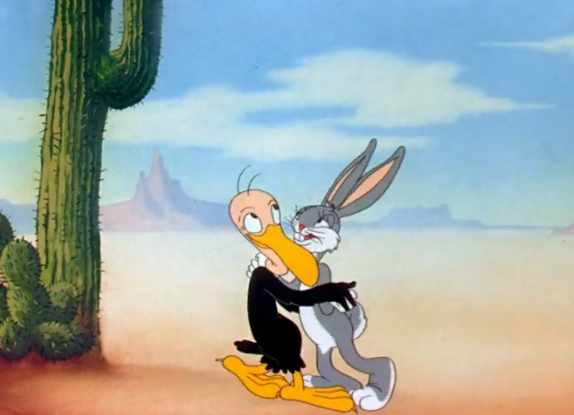
Bugs Bunny Gets the Boid
Directed by Robert Clampett
The mother buzzard sends her sons to get something for dinner. The slow-witted Killer (later known as Beaky Buzzard) is reluctant, but is told to at least get a rabbit. Of course, Killer soon sees Bugs and tries his best to capture him, but the buzzard is fooled too easily. Killer is an amusing character, Bugs is in his best trickster mode, the animation is brilliant, and there are many memorable gags (one involving a skeleton possibly being my favorite). Bugs also comes off as much more likable than in Clampett's previous cartoons with him (as strong as those were otherwise), as he has a clear motive for his actions here, unlike with Elmer in those couple of shorts. All in all, another amazing Bugs short. Beaky would make several more appearances in the cartoons (though not with Bugs), in addition to becoming a regular in the Looney Tunes comics.
10
Wacky Blackout
Directed by Robert Clampett
In this cartoon full of blackout gags (literally in a couple of cases), we see farm animals during the war. A running gag involves a woodpecker pecking a cat's tail. As typical in these spot gag cartoons, there's not much of a plot here, just the war being a connecting theme. Entertaining cartoon with a somewhat daring end gag (featuring the catchy song "We Did It Before", often heard in the WB cartoons of the era).
8
Foney Fables
Directed by I. Freleng
This spot gag cartoon features various fairytales and nursery rhymes, such as Sleeping Beauty, Tom Thumb, and the Grasshopper and the Ant in parodic versions (of course with wartime references in some of them). The running gag is about the Boy Who Cried Wolf, who is warned by the narrator that his pranks will eventually backfire on him. Fairytale parodies are something WB always did well, and while this might not be the absolute funniest take on them, it's an amusing one in any case. Also beautifully animated, including some surprisingly realistically drawn human characters.
8.5
The Ducktators
Directed by Norman McCabe
While many war-related cartoons had already been released, this was WB's first to be entirely dedicated to making fun of the enemy, here specifically the leaders of the Axis powers. Mr. and Mrs. Duck are expecting a new hatchling, and soon a duck version of Hitler hatches out of a black egg. After failed attempts at art, he starts his political career, getting some gullible followers, including a goose version of Mussolini. Later on, duck Tojo joins them too. The Dove of Peace is horrified at the events. The wartime propaganda cartoons are one of the most controversial chapters in the Looney Tunes history... but at the same time, some of them are among the wildest cartoons the studio ever did. Some of them are rather mean-spirited by today's standards, but this one mostly avoids that by having the leaders of the Axis as a (deserved) target, instead of mocking the general population of the countries like some other cartoons of its kind, though some stereotypes are obviously still there to see. Great animation, clever gags, and an interesting story – probably the most pro-peace (while showing that war isn't always avoidable) of all the war-related cartoons. A brilliant short, though one that should really only be shown in a proper historical context.
10
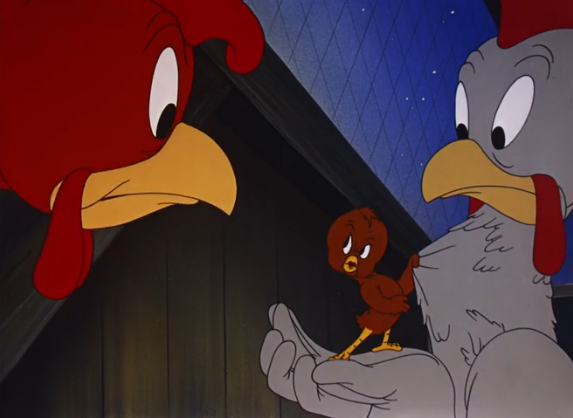
The Squawkin' Hawk
Directed by Charles M. Jones
A little chickenhawk doesn't want to eat a worm for dinner – he wants chicken, though his mother thinks he's too young for it. After being sent to bed without any dinner, he sneaks out at night and goes to the henhouse. But while he's trying to steal a chicken, a rooster foils the little hawk's plans. The little chickenhawk, only called Junior in this short, would be brought back a few years later with the new name of Henery Hawk. It might not be the most popular opinion, but the tough little guy has always been one of my favorite characters in the entire series – there's just something endearing about him. Most of the later Henery's personality is already here, with him trying to play tough against a much bigger rooster, though his voice is slightly different, and he seems to have less trouble finding a chicken (actually stealing one is a different story). Henery's debut elevates this cartoon quite a bit for me, though there are other parts I like too – some fast-paced chases, and the worm is an entertaining character (another non-speaking Jones character with a lot of personality).
9
Fresh Hare
Directed by I. Freleng
The mounted police are trying to catch Bugs Bunny who's committed various (petty) crimes. Elmer is the one with the task, but in a wintery chase, Bugs constantly outwits him. This is another great short with the usual strong chemistry between the lead characters. There are various funny visual gags, and while some of the antics are fairly similar to previous shorts, the winter theme keeps it... fresh, indeed. The short isn't entirely without weaknesses – the music in a gag involving posters at the start appears to have been messed up, and the minstrel show ending is badly dated, in addition to feeling very close to being just randomness for randomness' sake. But these flaws don't prevent it from being another good Bugs short.
9
Eatin' on the Cuff or The Moth Who Came to Dinner
Directed by Robert Clampett
A singing, piano-playing narrator tells the story of a moth and a honey bee who were in love. The two were to get married, but the moth got in trouble when a black widow spider set her sights on him. This is one of the few Looney Tunes to use live-action (for the scenes with the narrator), which gives it an interesting touch. The characters are both cute and funny, the moth being the star here, but the other insects (and the entertaining narrator) also get their moments to shine. Also a very rare short for the time in that the bride has to save the groom rather than vice versa (the following scene with "My hero" etc. appears to parody that cliché)! There's a sweetness to it that Clampett's shorts might not have very often, but it's still very recognizably his. Among the best one-shots of its time!
10
Fox Pop
Directed by Charles M. Jones
Two crows see a red fox destroying a radio. The fox tells the story of how he heard a radio ad for the Sterling Silver Fox Farm. He painted himself silver and got himself trapped on purpose, thinking it was a great place for foxes until he found out his skin would be used for a cape. Another good cartoon with a likable lead character, I especially enjoyed the way the story was told, starting with a strange scene that's only explained through the past events. There are some fun gags and reactions along the way. The ending in particular is a priceless one!
8.5
The Impatient Patient
Directed by Norman McCabe
Daffy is delivering a telegram to Chloe. But he gets the hiccups, so he goes to meet Dr. Jerkyl to get them cured. The doctor decides to try the scare cure, drinking a concoction that turns him into a monster, and Daffy has to get away from him. This cartoon is quite a crazy one, with the fast pace and gags resembling a Clampett cartoon. Storywise, it isn't the strongest entry of the time (it can feel a bit too random at times), but an enjoyable watch anyway.
8
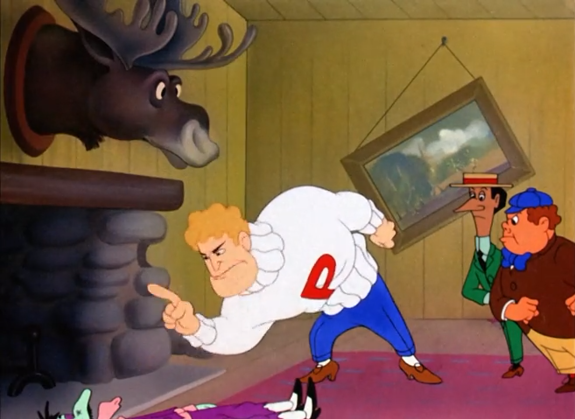
The Dover Boys at Pimento University or The Rivals of Roquefort Hall
Directed by Charles M. Jones
These titles are sure getting long! Tom, Dick and Larry, better known as the Dover Boys, have to save their fiancée Dora Standpipe from their archenemy, "coward, bully, cad and thief" Dan Backslide. A comedic short set in the 1890s wasn't an all new idea in the Merrie Melodies, previous examples having been "Those Were Wonderful Days" (1934) and "Love and Curses" (1938). But as charming as those two cartoons were, it's clearly third time lucky in this case. The exaggerated character acting from the 1938 short is repeated here in an even funnier way, there are a lot of entertaining gags and catchphrases that are known by pretty much everyone now. And no matter how many times you've heard them ("Unhand her, Dan Backslide!"), they still retain their comedic value. It's an influential cartoon, often considered Jones' first masterpiece (I'd say his second, but anyway). The strange but effective animation smears are something that have been used in countless cartoons later on, as have the stylized designs. An undeniable all-time classic.
10
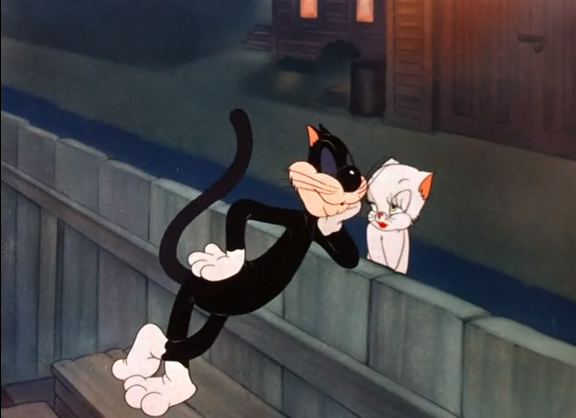
The Hep Cat
Directed by Robert Clampett
A night with a singing, tap-dancing cat. He tries to impress a girl cat and gets chased around by Rosebud the dog (a very similar character to the earlier Willoughby) who comes up with various schemes in an attempt to outwit the feline. Eight years after Merrie Melodies made the switch, this was the first cartoon in the Looney Tunes series to be produced in color, though part of the series would still be in black and white for a while. And for that first, they certainly chose a great short. The cat has a simple but good-looking design, his voice and singing gives him a lot of appeal, and the cartoon is just fun all around – full of the wild animation that Clampett's cartoons are known for. There are many great gags, especially the ending (the basic idea of which was later recycled in a Bugs Bunny cartoon), and the soundtrack is also perfect with many catchy tunes like "Five O'Clock Whistle" and "Java Jive".
10
The Sheepish Wolf
Directed by I. Freleng
A dumb sheepdog is watching over a flock of sheep. A wolf comes up with a plan to disguise himself as a sheep to fit in with his prey. After a black sheep realizes there's a wolf in sheep's clothing around, the sheepdog tries his best to find and catch him. A comedic entry with entertaining characters – and the first but definitely not the last time the series would feature a wolf and a sheepdog! The story takes a nice turn near the end when the sheepdog tries to prank the wolf back and we get another fairytale parody. The ending also has a great twist!
8.5
The Daffy Duckaroo
Directed by Norman McCabe
Crooner and film cowboy Daffy Duck quits his job, moving to the Wild West. He falls for a Native American female duck, but ends up angering her human boyfriend and eventually the entire tribe. Not one of the best-known shorts in the series (maybe due to the expected stereotypes, though there have been worse cartoons in this regard), but Daffy is very entertaining here. His character acting is great and the gags are amusing (including another wartime reference), in some cases quite imaginative! And then there's Daffy's performance of "My Little Buckaroo" that starts the cartoon – sheer fun!
9.5
The Hare-Brained Hypnotist
Directed by I. Freleng
Elmer has learned hypnosis in order to use it in hunting. After successfully hypnotizing a bear, he tries to do the same to Bugs, which doesn't go as well. Eventually it's Bugs who hypnotizes Elmer to think he's a rabbit, but this backfires massively. A great short – the first cartoon where Bugs and Elmer's roles are switched, which is hilarious. Bunny Elmer is especially funny, and it's refreshing to see a short where things don't always go well for Bugs (more common in the early days, but still relatively rare). The ending is also an imaginative (and somewhat topical) one.
9.5
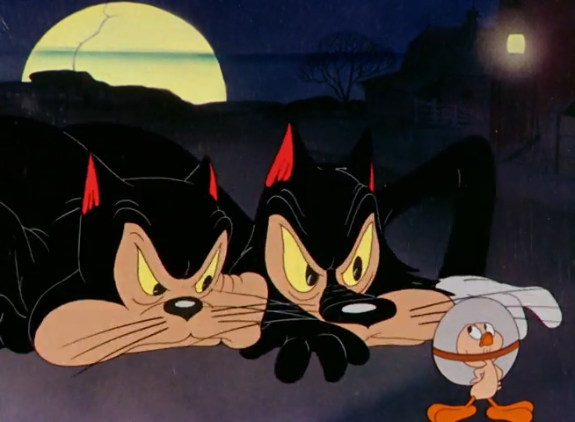
A Tale of Two Kitties
Directed by Robert Clampett
Two cats, Babbit and Catstello, try to catch a little bird sleeping in his nest. Catstello comes up with the plans and Babbit is the one to carry them out (despite being scared), but the bird foils them, often very violently. Babbit and Catstello would appear a couple more times after this cartoon, though with a drastic redesign. But the most significant character here is of course the bird – an early version of Tweety! He already has his recognizable voice, and his first line is the iconic "I tawt I taw a putty tat". But in addition to being colored pink, Clampett's version of the character is downright sadistic in his treatment of the cats – after each childish reaction to their misfortunes, we see a huge smirk on his face. While this is obviously very different from most of his later portrayals, it's very entertaining especially thanks to the contrast with the cute design. Clampett (through Babbit) even takes a shot at the censors, maybe not having expected to get away with some of the content in the short. A great cartoon all around.
10
Ding Dog Daddy
Directed by I. Freleng
A dumb dog tries to get a girlfriend without success. But then he spots a statue of a dog named Daisy, and mistaking it for a real dog, falls in love with it. He tries to meet his "girlfriend" despite a bulldog guarding the yard she's in. Eventually things take a tragic turn... A cartoon about a dog falling in love with a statue, and it's a great one – shows that the WB crew could make anything work! The main character is an appealing one with some funny reactions to being "kissed" by Daisy when lightning strikes, and the bulldog fares well too. And despite such a ridiculous concept, there are even a couple of more emotional moments.
9.5
My Favorite Duck
Directed by Charles M. Jones
Porky goes on a relaxing camping trip... or it would be one if not for Daffy being there and constantly annoying him. Every time Porky tries to deal with Daffy, the latter reminds him he'll be fined if he harms a duck. While Porky and Daffy had appeared together many times, this cartoon puts them in the roles they'd be mostly seen in later on, with Porky being the straight man and Daffy his comic foil. And this works brilliantly, including here. The characters' chemistry is great, there's a good reason why Porky doesn't immediately put a stop to Daffy's antics, the gags are done amazingly, and Jones gives the characters his typical expressiveness. A wonderful short.
10
Case of the Missing Hare
Directed by Charles M. Jones
Magician Ala Bahma is posting ads for his performance all over, even on the tree Bugs lives in! He takes offense at this, especially after the magician throws a blueberry pie in his face. He takes revenge by ruining the magician's performance. The basic plot of Bugs comically taking revenge on someone who has wronged him would be used in several later cartoons, especially by Jones himself. Some of the later versions may have been slightly more memorable, but this is also a great one. Bugs is funny as always, and while his vengeful actions might at times be even more humiliating than what had been done to him, the other character is unlikable enough for you not to feel sorry for him. The visuals are interesting – the stylized colorful backgrounds sometimes even change mid-scene in reaction to something that happens. The animation is nice and full of personality too.
9.5
In addition to the Looney Tunes and Merrie Melodies, the Schlesinger studio produced a 90-second war bond advertisement for the U.S. Treasury, featuring their biggest star character.
Leon Schlesinger presents Bugs Bunny
Better known as "Any Bonds Today?" after the featured song. Bugs performs a song asking the audience to buy war bonds and stamps to support the defense effort. He also impersonates both Uncle Sam and Al Jolson, and Elmer and Porky join in at the end. Of course, you can't expect the usual wackiness (even with Clampett as the director!) here given the short's theme and purpose, but for an ad, it's an entertaining one – the song is catchy, Bugs' voice expectedly gives it a lot of charm, and the animation is great as usual. At the same time, it's clearly a product of its time – besides the topical theme, the Jolson impersonation (complete with his trademark blackface makeup) is a gag that's aged very badly. But even with its slight flaws, I doubt a much more memorable war bond ad could have been conceived.
9
The WB cartoons are truly starting to reach their prime, as this year had many of the most amazing entries so far. All the directors (including relative newcomer McCabe) delivered at least one absolute masterpiece, and Chuck Jones deserves a special mention – this is the year when he achieved greatness as a director for the first time. The Bugs Bunny cartoons continued their impressive run, and we got new characters to look forward to more from, Tweety of course being the most notable one. The schedule of the two cartoon series will be cut down by around ten shorts the following year, but the studio will have interesting new side projects that I'll also cover here.
-
 4
4



6 Comments
Recommended Comments
Create an account or sign in to comment
You need to be a member in order to leave a comment
Create an account
Sign up for a new account in our community. It's easy!
Join the herd!Sign in
Already have an account? Sign in here.
Sign In Now